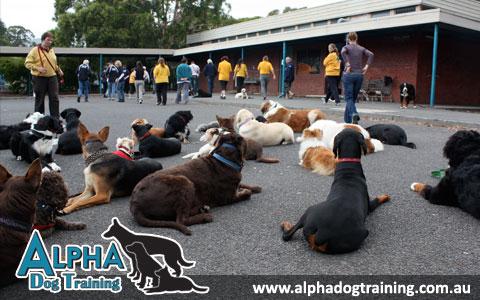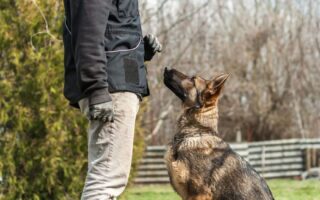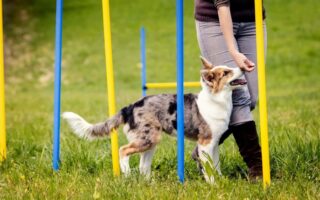In the realm of canine companionship, the term “alpha dog training” often evokes a vivid image: a confident owner standing tallest among their pack, wielding an unspoken authority that commands respect and trust. But what lies beneath this popular dog-training philosophy? Is it merely an antiquated notion rooted in misunderstood animal behavior, or does it hold valuable insights for fostering harmonious relationships between humans and their four-legged friends? In this article, we delve into the multifaceted world of alpha dog training, exploring its origins, principles, and applications in modern dog ownership. Join us as we navigate the balance between leadership and partnership, unveiling the keys to cultivating a well-behaved dog while ensuring a bond built on mutual respect and understanding.
Table of Contents
- Understanding the Alpha Dog Concept in Modern Training Techniques
- Building Trust and Respect: The Foundations of Effective Leadership
- Practical Strategies for Establishing Your Role as a Canine Leader
- Avoiding Common Misconceptions: Myths and Realities of Alpha Dog Training
- Q&A
- The Way Forward
Understanding the Alpha Dog Concept in Modern Training Techniques
The alpha dog concept has long been a focal point in the evolution of canine training, often associated with dominance and hierarchy within a pack structure. Traditionally, trainers emphasized the idea that dogs require a strong leader to thrive and learn effectively. However, modern approaches have shifted significantly from this philosophy, recognizing that positive reinforcement and building a strong bond between the dog and the owner lead to more effective training outcomes. This paradigm shift highlights the importance of mutual respect and communication over mere dominance.
In contemporary training techniques, the emphasis is on understanding canine behavior and harnessing it to foster a trusting relationship. Key aspects of this approach include:
- Positive Reinforcement: Rewarding desired behaviors rather than punishing undesirable ones.
- Socialization: Exposing dogs to different environments, people, and other animals to build confidence.
- Consistency: Maintaining consistent commands and expectations to reduce confusion.
Through these methods, trainers cultivate an environment that encourages cooperation rather than submission, showcasing that effective training is less about establishing dominance and more about creating an enriching learning experience.
Building Trust and Respect: The Foundations of Effective Leadership
In the journey of mastering alpha dog training, establishing a bond built on trust and respect is paramount. Just as a skilled leader cultivates an environment where team members feel valued and heard, dog training requires a similar approach. When your canine companion senses your authority is grounded in trust, they are more likely to follow your lead. This involves consistent communication, patience, and a clear set of expectations, which ultimately foster a stronger connection. Key practices include:
- Consistent Commands: Use the same words for specific actions to avoid confusion.
- Positive Reinforcement: Reward desirable behaviors to encourage repetition.
- Clear Boundaries: Establish limits that can help your dog understand acceptable behavior.
The respect between a trainer and their dog mirrors that of a leader and their team. Just like effective leaders motivate and inspire, trainers must engage their pets in a way that respects their individuality. Understanding each dog’s personality is crucial—it allows for tailored training strategies that not only enhance learning but also deepen mutual respect. Consider the following approaches:
| Training Approach | Expected Outcome |
|---|---|
| Building Rapport Through Play | Increased responsiveness during training sessions |
| Establishing Routine | Greater confidence and security for the dog |
| Socialization with Other Dogs | Improved behavior in varied environments |
Practical Strategies for Establishing Your Role as a Canine Leader
To establish yourself as a canine leader, it’s essential to foster trust and respect through consistent behavior and clear communication. Dogs are remarkably intuitive creatures that thrive on structure and predictability. By setting rules and boundaries, you create an environment where your dog understands what is expected of them. Here are some key practices you can adopt:
- Be consistent in your commands and expectations to reduce confusion.
- Use positive reinforcement to reward good behavior, strengthening your bond.
- Establish a daily routine to help your dog understand what to expect, including feeding, walks, and playtime.
- Engage in regular training sessions to sharpen their skills and reinforce your leadership.
In addition to consistency and routine, understanding canine body language plays a crucial role in asserting your leadership. Dogs communicate not just vocally but also through their posture and expressions. Observing these cues will enhance your ability to respond effectively. Consider the following aspects:
| Body Language | Interpretation |
|---|---|
| Relaxed posture | Comfortable, trusts you as a leader |
| Tail low or tucked | Submissive or anxious |
| Direct stare | Confident or challenging behavior |
| Play bow | Initiating play, friendly demeanor |
By interpreting your dog’s body language accurately and responding with patience and authority, you solidify your role as a leader and guide them towards being well-adjusted, happy companions.
Avoiding Common Misconceptions: Myths and Realities of Alpha Dog Training
In the world of canine training, the concept of “alpha dog training” is often surrounded by various myths that can mislead dog owners. One prevalent misconception is that dominance is the primary basis for successful dog training. In reality, dogs thrive on consistent communication, trust, and positive reinforcement rather than fear or aggression. Understanding a dog’s social structure is essential, but it doesn’t revolve solely around a hierarchy of dominance. Instead, it focuses on establishing a respectful relationship where the trainer leads with kindness and clarity. This approach fosters a deeper bond with your dog, promoting willingness to learn and comply.
Another widespread myth is that certain breeds inherently require a more “alpha” approach due to their perceived temperaments. However, every dog—regardless of its breed—benefits from a tailored training method that caters to its individual personality and needs. Establishing leadership in a positive manner doesn’t mean asserting control through harsh measures but rather guiding your dog with patience and consistency. When owners engage in practices such as reward-based training, they not only improve obedience but also enhance the dog’s overall well-being. Here’s a quick look at some common myths versus their realities:
| Myth | Reality |
|---|---|
| Dogs must see their owner as an alpha or they won’t listen. | Dogs listen best when trained with trust and respect. |
| Harsh methods are necessary to establish dominance. | Positive reinforcement encourages better long-term behavior. |
| Only certain breeds need strict training. | All dogs require tailored training regardless of breed. |
Q&A
Q&A on Alpha Dog Training: Understanding Leadership in the Canine World
Q: What exactly is alpha dog training?
A: Alpha dog training is a method based on establishing a clear hierarchy between the dog and its owner, emphasizing the owner’s role as the leader. This approach seeks to create a structured environment in which the dog learns to follow commands and behave appropriately. It’s often grounded in the belief that dogs, as pack animals, naturally respond to leadership roles established within their groups.
Q: Is alpha dog training rooted in science?
A: While the concept of pack hierarchy is drawn from observations of wild canines, many modern animal behaviorists argue that the dynamics are more complex than previously thought. Recent studies suggest that dogs perceive their relationships with humans in different ways that don’t strictly align with traditional dominance models. As such, while some elements of alpha training may work for certain behaviors, the scientific community is shifting toward understanding dog behavior through positive reinforcement and social learning theories.
Q: Can alpha dog training be beneficial for all dogs?
A: The efficacy of alpha dog training largely depends on the individual dog’s temperament, age, and past experiences. Some dogs thrive under structured commands and a clear leadership model, while others may react negatively to authoritative methods. Understanding your dog’s unique personality is crucial for determining which training approach is most suitable, as positive reinforcement techniques are often shown to yield better long-term results for a wide range of dogs.
Q: What are some common techniques used in alpha dog training?
A: Techniques often associated with alpha dog training include establishing yourself as the “leader of the pack” through consistent behavioral expectations, practicing controlled walks where the dog is taught not to pull, and using assertive body language to convey confidence. Additionally, techniques such as “nothing in life is free,” where a dog must earn treats or affection through obedience, are frequently utilized to reinforce the leader-follow relationship.
Q: How does alpha dog training differ from positive reinforcement methods?
A: Whereas alpha dog training focuses on establishing dominance and control, positive reinforcement methods emphasize rewarding desired behaviors to encourage dogs to learn and obey. The latter approach fosters a cooperative and trusting relationship between the dog and owner, often leading to more sustained behavioral changes. Many trainers today advocate for this more compassionate approach, viewing it as beneficial for building a strong bond without fear or intimidation.
Q: Are there any potential drawbacks to alpha dog training?
A: Yes, there can be several drawbacks to alpha dog training. If not executed properly, it might lead to fear or aggression, particularly in sensitive or anxious dogs. Stresses related to forced compliance can also harm the trust between a dog and its owner. Furthermore, an overemphasis on dominance may overlook the importance of understanding a dog’s emotional needs and social behaviors, which can be vital for effective training.
Q: What should a dog owner consider before choosing an alpha dog training approach?
A: Dog owners should carefully evaluate their dog’s breed, personality, and specific behavioral issues. Consulting with a professional trainer who understands various training philosophies can also provide guidance tailored to the individual dog’s needs. It’s essential to ask yourself whether the techniques align with your values as a pet owner and foster a safe, loving environment for your dog to learn and grow.
Q: Is there a middle ground between alpha and positive reinforcement training?
A: Absolutely! Many trainers advocate for a balanced approach that combines elements of both methodologies. This often entails setting clear rules and expectations while simultaneously creating opportunities for positive experiences that reinforce good behavior. The goal is to promote communication, trust, and mutual respect, allowing for a harmonious relationship built on both leadership and companionship.
—
In the world of canine training, understanding the varied philosophies allows for better choices that not only enhance your dog’s behavior but also strengthen the bond you share. Always remain open to learning, and remember that dogs thrive best in environments filled with love and understanding.
The Way Forward
As we conclude our exploration of alpha dog training, it’s clear that the journey to a harmonious relationship with your canine companion is as nuanced as it is rewarding. While the alpha concept has undergone scrutiny and evolution, the core principles of leadership and respect remain vital in fostering a balanced bond with your dog. By understanding your pet’s instincts and communication, you can nurture a partnership built on trust and understanding.
Whether you choose to embrace traditional methods or blend them with modern, positive reinforcement techniques, remember that every dog is an individual with unique needs. The key to successful training lies in patience, consistency, and, above all, love. As you embark on your training journey, keep in mind that each step taken is not just about teaching commands, but about forging a deeper connection with your furry friend.
So, gather your tools, harness your knowledge, and step forward into a world of mutual respect and joy. Every wag of the tail and playful bark is a reminder that at the heart of training lies the profound companionship that dogs offer — a bond that, when nurtured, will enrich both your lives for years to come.



